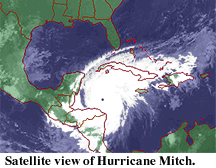

Located in the heart of gulf coast hurricane country, NWRC investigators have had first hand opportunities to study hurricanes such as Andrew (1992) and Georges (1998). From aerial damage assessment to recovery patterns, the research is an important aspect of NWRC's overall mission of understanding, preventing, and restoring wetland loss.
Current hurricane research at NWRC takes many forms. The Hurricane Mitch project in Honduras, for instance, is an interdisciplinary effort that combines the expertise of soil chemists, oceanographers, cellular biologists, and plant geneticists, to name a few. Hurricane Mitch caused massive destruction in sections of Honduras, Guatemala, and Nicaragua. At the request of USAID and in-country ministries, NWRC and collaborators at the University of Louisiana at Lafayette conducted projects to assess the ecological damage and recovery of mangrove forests, seagrass beds, estuarine systems and water quality, and shrimp populations.
Examples of the kinds of studies done after Hurricane Mitch include geographic information system (GIS) mapping of habitats, ecological studies of vegetation and soils, analyses of linkages between mangrove forests and shrimp pond water quality, evaluation of shrimp viral diseases, nuisance crustacean occurrence and effects in shrimp ponds, shrimp population genetic changes due to shrimp farm releases, and analyses of forest wind-throw patterns via aerial video. In addition to the ecological work described above, other divisions of USGS assessed such problems as flooding, landslides, and mapping of affected municipalities and established GIS clearinghouse data nodes in several locations that will be turned over to the affected countries.
Other, more general, programs of study use our current understanding to accurately describe the paths of hurricanes occurring in the earliest portions of the past century and to simulate, via computer modeling, their likely frequency and impacts well into the future.
Research
See Also Hurricane Special Feature
- 6/19/03
See Also Hurricane Lili Special Feature
- 10/10/02
See Also Hurricane Mitch Special
Feature - 6/19/03
Return to Research Issues
This document prepared by the National Wetlands Research Center
URL - http://www.nwrc.usgs.gov/about/web/hurrstdy.htm
Last Modified: 6/20/2003 (SBH)
Contact: nwrcweb@usgs.gov